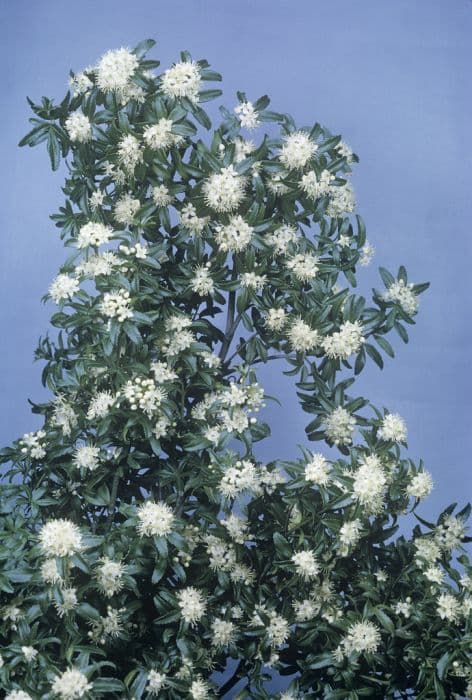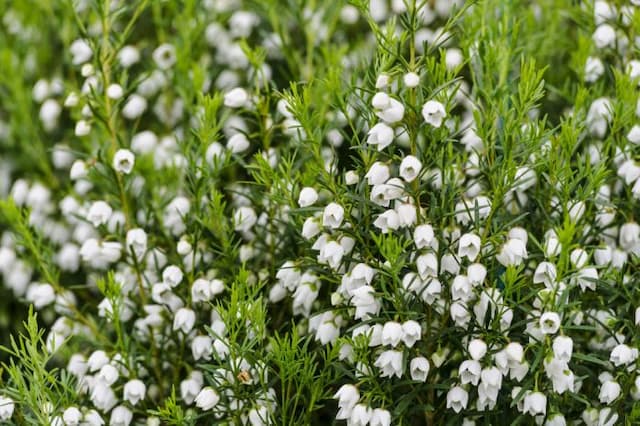Burning bush Dictamnus albus var. albus

ABOUT
Dictamnus albus var. albus, commonly known as the white dittany or the gas plant, is a perennial herb known for its unique and striking appearance. The plant features a bushy clump of glossy, lance-shaped, green leaves that emanate from the base. During its bloom period, larger showy terminal clusters of flowers come to life; these flowers are star-shaped, equipped with five petals, and predominantly white, which may sometimes exhibit a soft pink hue or flush towards the petal edges. Adding to its allure, the blooms are notable for the long stamens that extend outwards, giving the flowers a slightly frizzy look. The blooms are arranged in elegant spikes that rise above the foliage, creating an eye-catching contrast against the deep green leaves. The flowers also possess a distinctive and refreshing citrus or lemony scent, which can be quite pronounced particularly on warm evenings. After the flowering phase, the plant forms a fruit which is a capsule that adds textural interest to the plant even after the flowers have faded. One of the most fascinating characteristics of the white dittany is its ability to produce volatile oils, which can be ignited on a hot day, leading to its nickname of the "burning bush." This phenomenon is where the common name "gas plant" derives from. However, it is very rare and requires specific conditions to be observed. All these features come together to form a plant that not only appeals visually with its bloom but also adds an aromatic aspect to gardens, making the white dittany a sought-after plant for gardeners who wish to add a sensory layer to their landscapes.
About this plant
 Names
NamesFamily
Rutaceae.
Synonyms
Burning Bush, Gas Plant, Dittany, White Dittany, Fraxinella.
Common names
Dictamnus albus var. vulgaris, Dictamnus vulgaris, Dictamnus fraxinella Pers.
 Toxicity
ToxicityTo humans
Burning bush, also known as Dictamnus albus var. albus, contains various toxins and can be poisonous if ingested. The main toxic components are furoquinoline alkaloids and psoralens, which can cause photosensitivity in humans. If ingested, the plant parts can lead to stomach irritation, nausea, vomiting, diarrhea, and in severe cases, convulsions. Skin contact, especially followed by sun exposure, can lead to dermatitis and severe inflammation. The photosensitive reaction to the sun can result in blistering and a burning sensation on the skin, reminiscent of the plant's nickname, "burning bush."
To pets
Burning bush is toxic to pets as well for similar reasons it is to humans. If pets, such as dogs or cats, ingest parts of the burning bush, they may experience symptoms including vomiting, diarrhea, abdominal pain, and possibly tremors or seizures. The psoralens in the plant, combined with the ultraviolet light from the sun, can also cause photosensitivity resulting in dermatitis. Pet owners should prevent their animals from ingesting or coming into skin contact with the burning bush due to these toxic effects.
 Characteristics
CharacteristicsLife cycle
Perennials
Foliage type
Deciduous
Color of leaves
Green
Flower color
White
Height
2-4 feet (0.6-1.2 meters)
Spread
2 feet (0.6 meters)
Plant type
Herb
Hardiness zones
3-7
Native area
Europe
Benefits
 General Benefits
General Benefits- Ornamental Value: Dictamnus albus, commonly known as burning bush, is appreciated for its striking pink or white flowers which enhance the visual appeal of gardens and landscapes.
- Fragrance: The plant emits a strong lemon-like fragrance, especially in the evening, which can be enjoyed in gardens or when used in floral arrangements.
- Pollinator Attraction: The flowers attract a variety of pollinators, including bees and butterflies, playing a crucial role in supporting local ecosystems.
- Drought Tolerance: Once established, burning bush is quite drought-resistant, making it a good choice for sustainable, low-water-use gardens.
- Deer Resistance: Burning bush is known to be relatively resistant to deer, making it a suitable option for areas where deer browsing can be a problem for gardeners.
- Low Maintenance: Dictamnus albus requires minimal upkeep beyond the initial planting and occasional watering during dry spells, which can be ideal for gardeners seeking low-maintenance plants.
 Medical Properties
Medical Properties- Antimicrobial: Dictamnus albus has been traditionally used for its antimicrobial properties to help fight against bacterial infections.
- Antifungal: The plant has been used to treat fungal skin infections due to its antifungal components.
- Anti-inflammatory: It contains elements that may help reduce inflammation, making it potentially useful in treating conditions associated with inflammation.
- Analgesic: There is anecdotal evidence suggesting that it might have pain-relieving properties.
- Sedative: Some practices have used the plant for its sedative effect to alleviate anxiety and promote relaxation.
- Diuretic: Traditionally, it has been used to promote urine production and provide relief from fluid retention.
- Gastrointestinal aid: It has been used in folk medicine to help with digestion and relieve various stomach issues.
- Menstrual cycle regulator: There are accounts of Dictamnus albus being used to regulate menstrual cycles or relieve menstrual discomforts.
 Air-purifying Qualities
Air-purifying QualitiesThis plant is not specifically known for air purifying qualities.
 Other Uses
Other Uses- Insect repellant: The essential oils in Gas Plant can be used to deter insects and are sometimes used in natural insect repellant formulations.
- Phototoxic effects: The sap of the Gas Plant contains furocoumarins, which can be applied to the skin to create designs that will darken when exposed to sunlight, a practice not widely endorsed due to potential skin irritation.
- Perfumery: The aromatic compounds found in Gas Plant are occasionally used in the production of perfumes and fragrances, due to their lemon-like scent.
- Garden design: Gas Plant’s sturdy, clumping nature and attractive foliage make it a popular choice for use in structured garden designs like knot gardens or as borders.
- Illumination effects: The volatile oils in Gas Plant can create a flammable vapor on hot evenings, sometimes used by gardeners for dramatic evening demonstrations of 'burning' the plant without harming it.
- Natural dye: The roots of Gas Plant can be used to produce a natural dye for coloring textiles.
- Floristry: Due to its long-lasting blooms and attractive structure, Gas Plant is occasionally used in floral arrangements.
- Moth deterrent: The strong scent is said to keep moths away, so branches might be placed in wardrobes or amongst clothes for protection.
- Educational tool: Gas Plant can be used in botany education to demonstrate various plant characteristics such as volatile oils and defense mechanisms.
- Landscape restoration: Because it's resilient and can grow in poor soils, Gas Plant is sometimes used in restoration projects to stabilize soils and restore native vegetation.
Interesting Facts
 Feng Shui
Feng ShuiThe Burning Bush is not used in Feng Shui practice.
 Zodiac Sign Compitability
Zodiac Sign CompitabilityThe Burning Bush is not used in astrology practice.
 Plant Symbolism
Plant Symbolism- Purity - The white flowers of Dictamnus albus, commonly known as Burning Bush, often symbolize purity and innocence due to their color.
- Enlightenment - Burning Bush emits a flammable oil that can ignite in hot weather, making it a symbol for enlightenment and the illumination of mind or spirit.
- Protection - Historically, the plant was thought to have medicinal properties and was used to ward off diseases, which attributes a protective quality to its symbolism.
- Mysticism - Owing to its unique ability to produce flammable vapors, the Burning Bush holds a mysterious or mystical symbolism, hinting at the unseen and the spiritual.
 Water
WaterThe gas plant (Dictamnus albus var. albus) prefers consistent moisture but does not like to be waterlogged. Water the gas plant deeply to encourage deep root growth, providing about 1 inch of water once a week during active growing periods. Reduce watering during the fall and cease supplemental watering during the winter months when the plant becomes dormant. It's important to avoid overhead watering to prevent fungal diseases; instead, water at the base of the plant. A mature gas plant will typically require around 0.5 gallons of water weekly during the peak of summer, depending on weather conditions.
 Light
LightThe gas plant thrives best in full sun to partial shade. It prefers a location that receives at least six hours of direct sunlight each day, which promotes the best flowering and plant health. Partial shade is acceptable, especially in regions with very hot afternoons, but too much shade can reduce blooming and lead to leggy growth.
 Temperature
TemperatureThe gas plant is hardy in USDA zones 3 through 8, tolerating temperatures down to -40°F and up to 90°F. It flourishes in temperate climates with an ideal temperature range between 60°F and 75°F. Extreme heat or prolonged frost can stress the plant, but it is generally resilient to temperature fluctuations within its hardiness zone.
 Pruning
PruningPruning of the gas plant is generally done to maintain shape and remove any spent flowers or damaged foliage. It's best to prune in the late fall or early spring, cutting back the plant to about 6 inches to promote vigorous growth and better air circulation. Deadheading, or the removal of faded flowers, can be done throughout the blooming season to encourage additional blooms.
 Cleaning
CleaningAs needed
 Soil
SoilGas plant thrives in well-draining, loamy soil with a neutral to slightly alkaline pH between 7.0 and 8.0. For the best soil mix, combine two parts garden soil, one part coarse sand, and one part compost. This will ensure good drainage and fertility.
 Repotting
RepottingThe gas plant is a perennial that does not like to be disturbed and typically does not need frequent repotting. It is best to repot only when necessary, possibly every 3-5 years, to refresh the soil without disturbing the roots too much.
 Humidity & Misting
Humidity & MistingGas plant tolerates a wide range of humidity levels and does not require a humid environment; it does well in the average humidity found in most outdoor garden settings.
 Suitable locations
Suitable locationsIndoor
Place gas plant near a sunny window and ensure good air circulation.
Outdoor
Plant in full sun with well-draining soil and space for growth.
Hardiness zone
3-8 USDA
 Life cycle
Life cycleThe life cycle of Dictamnus albus var. albus, commonly known as Gas plant or Burning bush, begins with seed germination which occurs in late spring or early summer, given adequate soil warmth and moisture. The seedlings develop into rosettes with distinctive compound leaves in their first year, establishing a strong root system. In the following years, the perennial plant resumes growth from the overwintering rootstock, and stems elongate, giving rise to vertical growth and the formation of buds. Flowering typically occurs from late spring to early summer, with the plant producing spikes of white or pink flowers that are attractive to pollinators. After pollination, usually by insects, seed capsules form and mature by late summer, eventually releasing seeds to complete the reproductive cycle. In winter, above-ground parts of the plant die back, while the root system remains dormant until the next growth cycle commences in spring.
 Propogation
PropogationPropogation time
Spring to Summer
The most popular method of propagating the Dictamnus albus, commonly known as Burning Bush or Gas Plant, is by seeding. The best time to sow the seeds is in fall or early spring. Since gas plant seeds have a tough outer shell, they require a pretreatment called scarification to improve their germination rates; this involves gently scratching or nicking the seed coat to allow moisture inside. Once scarified, the seeds should be sown in well-draining soil and placed in a sunny area. As they can take weeks or even months to germinate, patience is necessary when propagating by seed. For quicker results, gardeners often stratify the seeds by placing them in moist sand inside a plastic bag and refrigerating them for a period of 6 to 8 weeks to mimic winter conditions before planting. This cold treatment can enhance germination rates when the seeds are subsequently sown in warmer soil.


![Mexican orange [Sundance]](/_next/image?url=https%3A%2F%2Fplants-admin.emdemapps.com%2Fimages%2Fplants%2F%2Fimages%2F604b5381bcf0d.png&w=640&q=75)






![Mexican orange [Goldfingers]](/_next/image?url=https%3A%2F%2Fplants-admin.emdemapps.com%2Fimages%2Fplants%2F%2Fimages%2F604b5bdfad8cd.png&w=640&q=75)